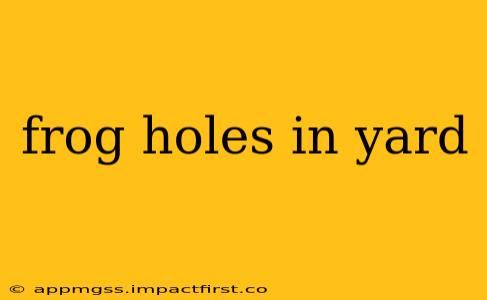Discovering frog holes in your yard can be a delightful surprise, indicating a healthy and thriving ecosystem. These amphibious friends play a vital role in pest control and maintaining biodiversity. However, understanding their behavior and habits can help you coexist peacefully and appreciate their presence. This guide will delve into everything you need to know about frog holes in your yard.
What Do Frog Holes Look Like?
Frog holes aren't always easily identifiable. They aren't typically elaborate burrows like those of other animals. Instead, frogs often utilize existing shelters, modifying them to suit their needs. You might find them:
- Under rocks and logs: These provide natural shade and protection.
- In dense vegetation: Tall grass, shrubs, and ground cover offer concealment and moisture.
- Near water sources: Frogs need access to water for hydration and breeding. Look for holes near ponds, streams, or even damp areas in your garden.
- Shallow depressions in the soil: Frogs may dig shallow pits for temporary shelter or to lay their eggs. These might be inconspicuous, appearing as slightly sunken areas of soil.
Why Do Frogs Dig Holes?
Frogs primarily dig holes or utilize pre-existing cavities for:
- Shelter: Protection from predators, such as birds, snakes, and larger mammals.
- Humidity: Frogs' skin needs to remain moist to breathe and regulate body temperature. Holes provide a humid microclimate.
- Hibernation (in colder climates): During winter months, frogs may burrow deeper to escape freezing temperatures.
- Laying eggs: Some species will create shallow nests near water sources to deposit their eggs.
How to Identify Different Frog Species by Their Holes?
It's difficult to identify a specific frog species based solely on its hole. The size and location of the hole may provide some clues, but visual identification of the frog itself is far more reliable. Observing the frog's size, coloration, and physical features are key to determining the species. Consider using a field guide specific to your region for accurate identification.
Are Frog Holes Harmful to My Yard?
Frog holes are generally not harmful to your yard. In fact, they are often a sign of a healthy environment. However, if you have concerns about excessive digging or damage to your plants, consider providing alternative shelter such as artificial frog houses or creating a more welcoming habitat with dense vegetation and a water source.
What to Do If You Find a Frog Hole in Your Yard?
Celebrating the presence of frogs is generally the best approach. Leave the hole undisturbed as much as possible; it's their home. If you're concerned about the safety of the frog, ensure that it has access to a water source and plenty of cover.
How Can I Attract More Frogs to My Yard?
Creating a frog-friendly habitat is a great way to encourage more of these beneficial creatures to your yard. This includes:
- Providing a water source: A pond, birdbath, or even a shallow dish of water will attract frogs.
- Planting native vegetation: This provides both shelter and food for frogs and their prey.
- Leaving leaf litter and debris: These provide essential hiding places.
- Avoiding pesticides: These can harm frogs and their food sources.
By understanding the habits and needs of frogs, you can welcome these beneficial amphibians to your yard and enjoy the benefits of a healthier ecosystem. Remember, coexisting peacefully is key to a thriving garden and a happy frog population.
